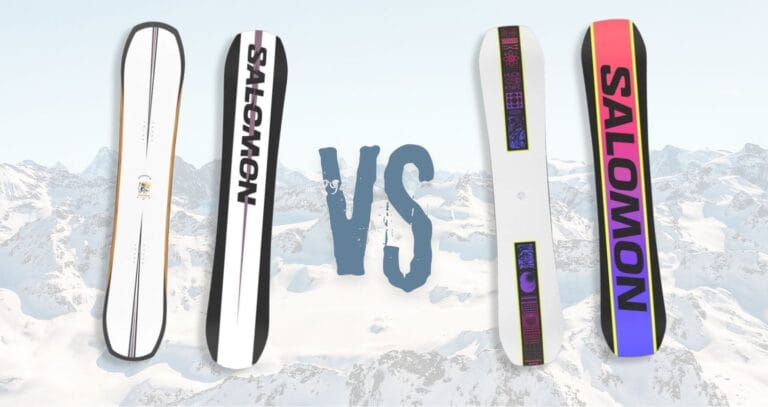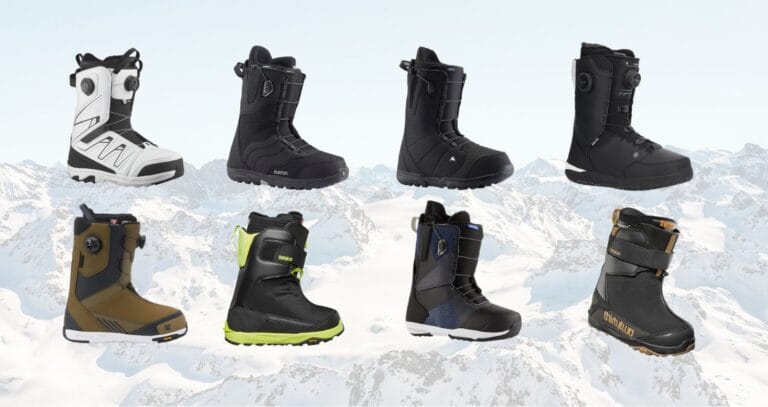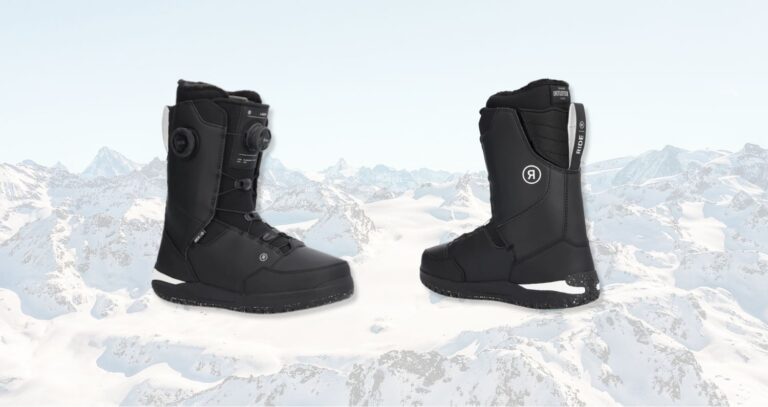Being in shape at the start of the season begins with snowboard workouts in the off-season.
Putting in the early effort will help you perform better, protect you from injuries, and allow you to ride harder and longer every precious day you get on snow.
Throughout my 30+ years riding, I’ve amassed tips from physiotherapists, physical trainers, yoga teachers, Olympic coaches, and pro riders all of which center around three areas of focus:
- Balance and mobility
- Strength
- Cardio
Keep reading to learn how you can be in tip top shape for snowboarding!
Balance and Mobility Training for Snowboarding
The main benefits of balance and mobility training for snowboarding are twofold:
- Injury prevention
- Style and performance benefits
Snowboarding is a sport where we are constantly in the act of balancing. As opposed to skiing, we are constantly balancing on only one edge at a time. We are also constantly shifting our balance between our front foot and back foot.
The more mobility you have the less likely you are to injure yourself because of twisting or sudden movements that require you to move to the maximum of your range of motion.
Dynamic, energetic, and powerful snowboarding all require a large range of motion which can be accessed at will by the rider. Being able to move in and out of balanced positions is how we add style and strength to freestyle tricks.
Board performance in snowboarding (i.e., bending your snowboard in turns resulting in built-up and then released energy in the snowboard) comes in part from being able to use range of motion to its fullest.
The following tips on how to improve balance and mobility in the off-season are as follows:
- Balance board
- Yoga
- Balancing exercises
Balance boards for snowboarding
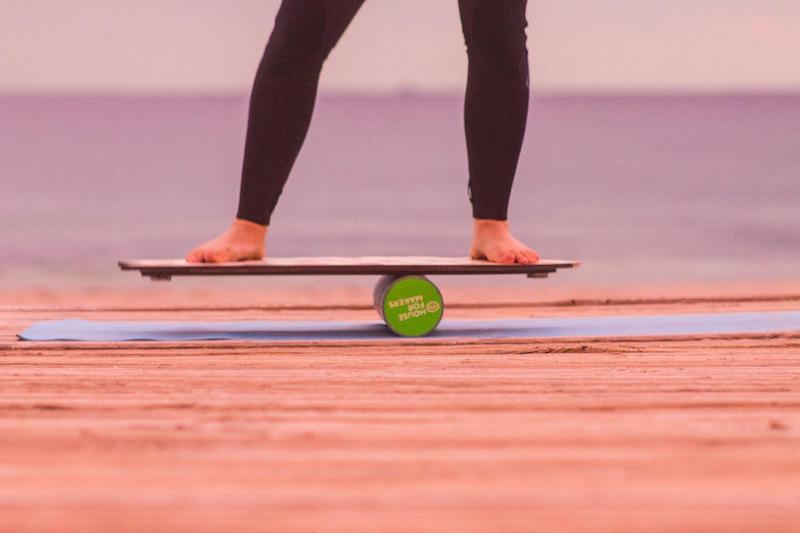
A balance board is a a great tool to invest in for any snowboarder.
A simple DIY alternative is taking an empty 2L pop bottle, filling it with water, and balancing on it with an old skateboard deck.
I set up a standing desk at home and stood on one of these while working to nest my balance workout into my daily responsibilities.
After finding a balanced position with the roller between both feet, try to shift the center of balance to one foot and then to the other. When doing boardslides on boxes or rails, we often balance on only one foot.
Yoga
The physical practice of yoga, aka the asanas, is a sure-fire way to increase balance and mobility for snowboarding in the long run.
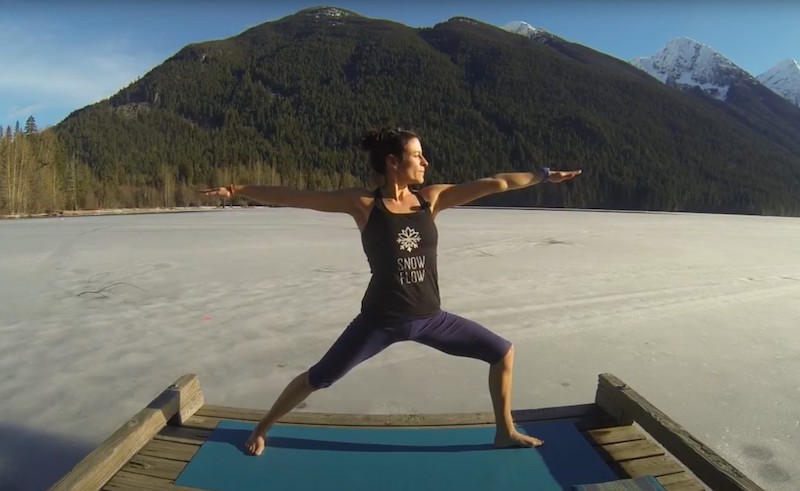
Simple sequences of asanas, such as the Sun Salutation, are good because they move your body through its range of motion in a memorable, repeatable, and easy-to-follow routine.
Check out a Snowflow routine built by SnowboardSelector contributor and yoga teacher Claire Thiebaud, as a good place to start.
Balancing exercises
Balancing exercises can range from basic to advanced and can be more or less challenging in a few simple ways.
As part of my knee rehab following an ACL tear, I learned the following from my physiotherapist and my physical trainer:
- Stand on one leg.
- Stand on one leg and look up towards the ceiling.
- Stand on one leg and close your eyes.
- Do this on both legs.
Next, to add a challenge:
- Stand on one leg in the center of a kitchen tile.
- While balancing, lean down and touch the four corners of the tile while rising between each touch.
- Do this on both legs.
Next, to exercise the fast-twitch muscles we need to activate when going over bumps or landing jumps, try the following:
- Balance on one leg, incline so that your chest is parallel with the floor, and then quickly move back to a vertical position. Try this several times.
Strength Training for Snowboarders: Core and Lower Body Exercises
I saw a video where famed Canadian snowboarder Mark McMorris took a brutal crash in Switzerland and when he regained his breath he said, “This is why I go to the gym. Not because I love the gym and big muscles, but because I love snowboarding and it’s how I survive crashes like this.”
Not all of us need to be able to survive crashes of that scale, but being strong will prevent injuries, increase performance, and allow you to ride longer each day you’re out.
While full-body fitness is important, two key areas for snowboarders are:
- Core strength
- Lower-body strength
*The following exercises are what I’ve used over my years of riding and have worked for me. Neither Snowboard Selector nor I, take any responsibility for any injuries that occur from the following exercises and advice from certified professionals should be sought if you have any previous injuries or conditions.
Core Strength for Snowboarding
Core strength, meaning the muscles in your abdomen that surround your spine, is key for powerful snowboarding, fast spins in the park, and keeping your back healthy as you rip down any terrain.
Building core strengths can be done with body weight alone. The following exercises are a good way to start:
1. Planks
- Lie flat with your belly on the ground.
- Keeping your knees on the ground, lift up your abdomen by resting your weight on your forearms.
- For added challenge, lift your knees from the ground and balance on your toes and your forearms.
- Hold this pose and feel the burn in your core muscles.
2. Side planks
- Lie the side of your body on the ground.
- Place your elbow on the ground so that your forearm is perpendicular to your body.
- Lift your body weight so that you are balancing on your forearm and the side of your foot.
- For added challenge, lift the upper leg upwards.
- Hold this pose and feel the burn in your obliques (i.e., the side abs)
3. Boat Pose
- Sit on the ground with your back straight and your legs straight in front of you.
- Lean back and lift your legs upward.
- Hold this pose and try to create a “V” shape with your body.
There are many more core exercises that exist, but these three are what I’ve used over the years and cover the main muscle groups that protect your spine.
Lower-Body Strength for Snowboarding
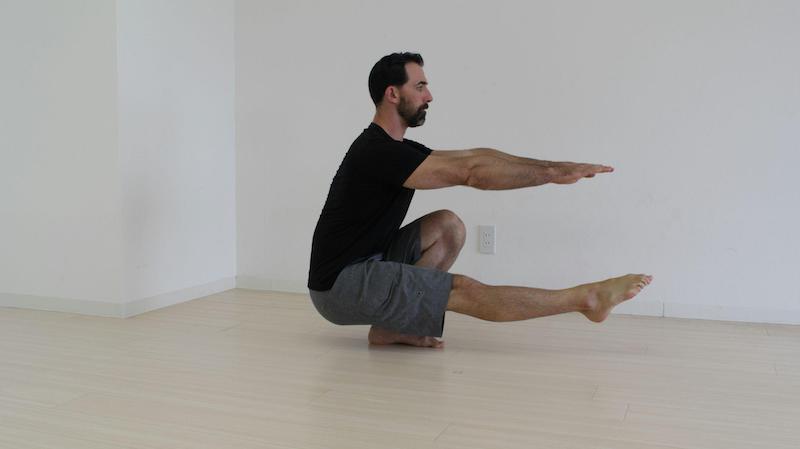
Having a strong lower-body protects your knees and back while riding and also helps you absorb bigger impacts from larger airs or bumps.
My physiotherapist, Mike Conway, who works with Olympic teams and is a snowboarder himself, told me that if a snowboarder can’t do a one-legged squat and come back up, their knees are not protected by enough muscle strength.
It’s a tough maneuver, and I suggest you give it a try. The good news is that strength can be built over time. The muscle groups to focus on are:
- Quadriceps
- Hamstrings
- Glut med and max
- Calves
- Tibialis (the one next to the shin bone)
Some classic exercises are:
1. Quadriceps – Squats and One-Legged Squats
- A good starting point for one-legged squats is to place a chair behind you and practice sitting and standing up from the chair, first with two and then with one leg.
2. Hamstring – Lifts
- Lie on your back on the ground with a chair or low table at your feet.
- Place your lower legs (from the knee down) on the support.
- Lift your abdomen upwards while keeping your shoulders on the ground and then bring it back to the ground.
- Repeat this movement.
- For added challenge, do this with one leg instead of two.
- For even more challenge, back up so that it is just your heels that are on the support.
- Again, start with two leg lifts and then move to one.
3. Glutes – Med and Max – Side leg lifts
- Lie on your side and lift your upper leg.
- Lower the upper leg and repeat the movement.
- For added challenge, place an exercise elastic over both legs to add resistance.
4. Calves – Calf Lifts
- Grab a support that gives you a slight lift above ground level, such as a book or a yoga block.
- On one leg, place the ball of your foot on the support and allow the heel to hang off the end.
- Raise yourself, using your toes, and lower yourself.
- Repeat this movement several times to feel the calf muscle working and then switch legs.
*Calf raises can also be done at a standing desk while working!
5. Tibialis – Resistance band toe raises
- Lie on the ground with your legs out with a resistance band fastened securely in front of them.
- Place the loop of the band around your toes so that it gives resistance as you flex your foot towards your body.
- Repeat this movement until you feel the burn.
*This movement is the movement we use to fine-tune the edge angle on our while riding on our heel side edge.
Cardiovascular and Endurance Workouts for Snowboarding
Being able to do multiple laps and longer runs comes down to endurance and cardiovascular fitness.
To make the most of your lift ticket, the following exercises are a few ideas to build your fitness during the off-season:
- Running
- Long-distance cycling
- Hiking (with or without weight vest)
- Swimming
- Stair climbing
- HIIT (High-Intensity Interval Training)
Whatever your chosen activity, the rule of thumb is to do it for at least 20 minutes to build your cardiovascular fitness.
If you’re looking for an extra challenge, put on a weight vest and/or find a mountain to climb, run, or cycle up.
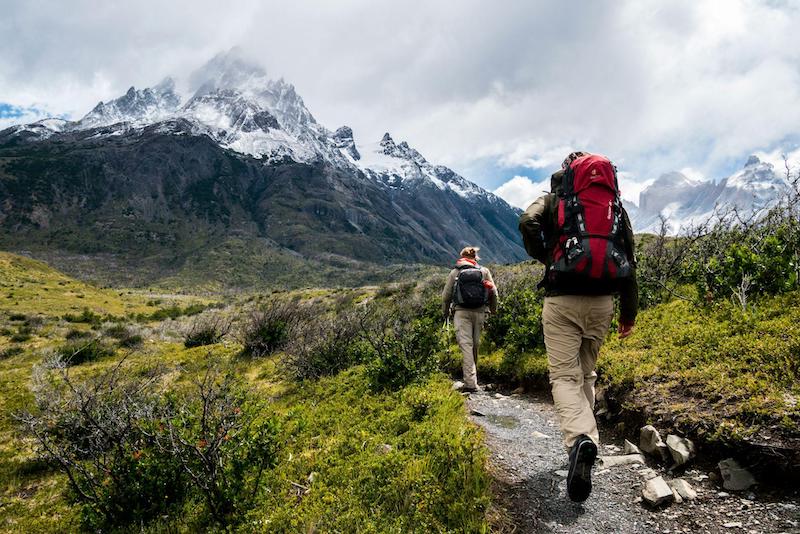
Weekly Off-Season Workout Routine
As stated earlier, I’m not a fitness professional but this off-season snowboard workout routine has kept me going strong for over thirty years of snowboarding with minimal injuries.
I do the same routine every “Exercise Day,” have a “Rest Day” every second day, and take Sundays to do cardio training.
My physio once told me that it’s been clinically proven that three exercise days per week is optimal and adding a fourth doesn’t produce any benefit.
Every “Exercise Day” takes about 20 minutes in total; each exercise is done for 45 seconds; each exercise is followed by 60 seconds of rest. The routine consists of:
- Sun Salutation sequence – 4x
- Balance Exercises
- Core – Plank
- Squats
- Core – Side Plank
- Hamstring lifts
- Core – Boat Pose
- Squats – One-legged
- Glutes – Side leg lifts
- Core – Plank
- Sun Salutation sequence – 4x
Here’s what it looks like in practice:
- Day 1 – Exercise Day
- Day 2 – Rest Day
- Day 3 – Exercise Day
- Day 4 – Rest Day
- Day 5 – Exercise Day
- Day 6 – Rest Day
- Day 7 – Cardio Day
To make my cardio day intensive, I wear a weight pack, which is currently a 15kg three-year old! Layering family time over workout time is full of benefits.
During my work day, I set up a standing desk and alternate between balancing on a balance board and doing calf raises.
Conclusion
Getting into a fitness routine in the off-season will do wonders for the physical and mental strength needed to progress your riding when the snowflakes begin to fall.
The exercises listed in this article work for me and are a good starting point for you. It’s important to listen to your body, to listen to professionals, and take the time to develop a routine that works for you.
Consistency is key to improving our fitness. To keep me motivated, one thing I do on my exercise days is put on a snowboarding movie while I work out. So find what works for you and get to it!
Thanks for reading!

